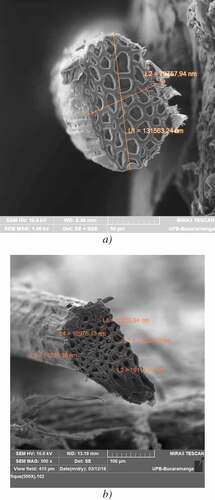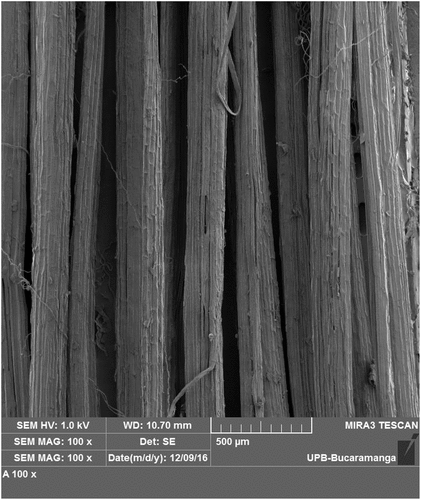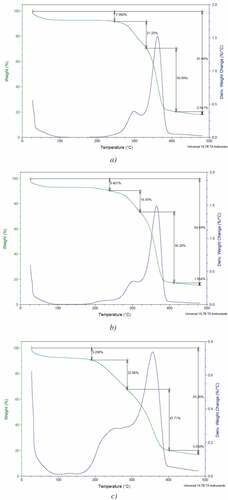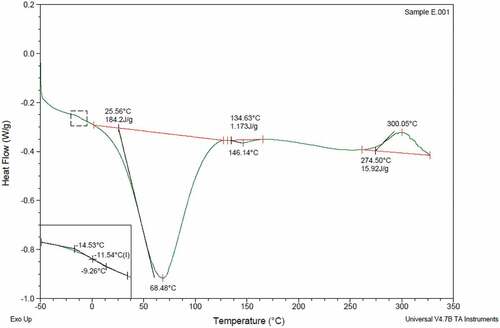Abstract
Bio-insulations have gained great interest in recent years due to their potential to reduce energy consumption without negative environmental impacts. Fique is one of the most important crops in Colombia, it has shown a low thermal conductivity which makes it a potential replacement for the common insulation materials. However, there are few works that study its thermal properties. In order to enhance the understanding of fique as thermal insulation, in this paper a morphological analysis of raw fique fibers and Thermogravimetry (TGA) and Differential Scanning Calorimetry (DSC) tests of three fique samples are presented, namely, natural fique without treatment, fique washed with a commercial softener and fique after having been soaked for 24 hours in the same softener.
PUBLIC INTEREST STATEMENT
Buildings consume around 40% of world’s energy, which greatly contributes to global warming, so it is essential to reduce that consume. One of the best ways to do it is by means of thermal insulators because it minimizes heat losses when heating or air conditioner systems are used. However, common thermal insulators cause environmental problems and serious human health problems, motivating the use of bio insulation materials made from natural and recycled products. Fique is a plant of great importance for Colombia, recent studies have shown that thermal conductivity of materials derived from the fique can be compared with that of the common commercial insulators, nevertheless, other important thermal properties have not been studied. In order to deepen the knowledge of the fique as a thermal insulator, in the present work a morphological, TGA and DSC analysis of different fique samples is presented.
1. Introduction
Nowadays our society faces the great challenge of Global Warming, which has caused serious problems such as droughts, natural disasters, heat waves and global sea level rise (Haines, Kovats, Campbell-Lendrum, & Corvalan, Citation2006). This increase in Earth’s temperature is mainly due to increased emissions of greenhouse gases due to the use of fossil fuels in energy production. To face this problem, it is necessary to develop clean energy sources and reduce the energy consumption of society, which is directly related with the building sector since it is one of the sectors with the highest energy consumption worldwide. It is estimated that buildings consume around 40% of energy, 25% of water and 40% of the world’s resources; besides accounting for 1/3 of the global greenhouse gas emissions (EERE, Citation2018). This situation has stimulated research aimed at improving the energy efficiency of buildings, which is evidenced by the increase in studies on the subject (De Boeck, Verbeke, Audenaert, & De Mesmaeker, Citation2015) and in the emergence of regulations about it (C. E. para A. L. y el Caribe, Citation2014; Schiavoni, D׳Alessandro, Bianchi, & Asdrubali, Citation2016).
Within this context, thermal insulators are of great importance since its use is recognized as one of the most efficient ways to reduce energy consumption in buildings (Schiavoni et al., Citation2016; Tangjuank, Citation2011; Papadopoulos, Citation2005; Liu et al., Citation2017). By using them, energy losses can be reduced through the walls and ceilings of buildings, which result in a significant reduction in energy consumption when heating or air conditioner systems are used. As can be seen in the works of Nandapala and Halwatura (Nandapala & Halwatura, Citation2016) and Siggelsten and Said (Siggelsten, Citation2018). However, common thermal insulators are materials made from petrochemical products, such as polystyrene, or from natural sources processed with high-energy consumptions, such as rock wool and fiberglass. This causes environmental problems, due to the high energy consumption, pollutant emissions and waste generation, mainly in the production stage (Liu et al., Citation2017; Asdrubali, D’Alessandro, & Schiavoni, Citation2015) and serious human health problems caused by its harmful components (Binici, Aksogan, & Demirhan, Citation2016; Mati-Baouche et al., Citation2014; Mounika, Ramaniah, Ratna Prasad, Rao, & Reddy, Citation2012). These problems have motivated the use of bio insulation materials made from natural and recycled products, which could be developed without requiring high energy consumption and without risk to health. Bio insulations have been studied since 1974 but aroused great interest since 2010 to present, due to the increased use of air conditioning systems, greater environmental awareness and changes in the uses of biomass (Liu et al., Citation2017). A full review of this topic can be found in the works of Liu et al. (Citation2017), Asdrubali et al. (Citation2015), Lopez Hurtado, Rouilly, Vandenbossche, & Raynaud (Citation2016), Madurwar, Ralegaonkar, & Mandavgane (Citation2013), Ingrao et al. (Citation2015) and Kymäläinen y Sjöberg (Citation2008).
Fique (Furcraea bedinghausii) is a plant of great importance for Colombia, to the point of being the first producer worldwide with a production of about 30,000 tons/year (Navacerrada, Díaz, & Fernández, Citation2014). However, there are few works about its use as thermal insulation. In the reported studies it has been shown that thermal conductivity of materials derived from the fique can be compared with that of the common commercial insulators (Navacerrada et al., Citation2014; Muñoz & Cifuentes, Citation2007; Navacerrada et al., Citation2016; Navacerrada et al., Citation2013; Monsalve, Bolañoz, Lopez, & Toro, Citation2014). Some of the mentioned works, the ranges of thermal conductivity obtained, the method used for its measurement and the sample characteristics are shown in Table . Nevertheless, other important thermal properties have not been studied, such as specific heat, which is crucial data for the evaluation of thermal dynamics properties. In order to deepen the knowledge of the fique as a thermal insulator, in the present work a thermal study of three fique samples is presented, namely, natural fique without treatment, fique washed with a commercial softener and fique after having been soaked for 24 hours in the same softener. It is presented a morphological analysis and the results of Thermogravimetry (TGA) and Differential Scanning Calorimetry (DSC) tests of the samples.
Table 1. Thermal conductivity of insulations based in fique fibers
2. Materials and methods
When studying the performance of bio insulations, tests are usually carried out on samples manufactured by means of one of the following methods: bonding molding, pressing molding, hot-pressing molding, injection molding, foaming molding, in natural (original/raw) form and others, e.g. needle-punching and hydroentanglement, aerosol processing method (Liu et al., Citation2017). In this work the performance of raw fique fibers was studied, therefore, tests were carried out with fique samples in natural form. In order to have a better knowledge of the constitutive form of the fique fibers some raw fibers were cut crosswise and observed in the Field Emission Scanning Electron Microscope (SEM) of the “Universidad Pontificia Bolivariana” (TESCAN—MIRA 3 FEG-SEM). Uncut fibers were also observed in the Microscope SEM.
In addition, tests were carried out on the fique washed with Soflan Suavitel ®, a commercial fabric softener used to clean sediments deposited on the surface of the fibers, composed of a cationic surfactant type quaternary ammonium salts, fragrance, dye, preservative and water. In order to analyze the relationship between the thermal properties and the effect of the softener in the washing process, in spite of the raw fiber samples, two types of samples of fibers washed with softener were used: one removing the softener instantaneously (passed through softener) and the other after leaving them to soak for 24 hours. To determine the fiber weight changes with temperature, and thus to have a measure of the samples thermal stability, the Thermogravimetry (TGA) method was used, by means of the TA Instruments Q500 TGA test bench of the “Universidad Autónoma de Occidente” in Cali, Colombia. Sample masses were: 3.567 mg for raw fique and fique passed through a softener, and 3.276 mg for fique soaked in softener for 24 hours. All TGA tests were carried out at a heating ramp at 10◦C/min, from 25 to 500◦C. Scanning Difference Calorimetry (DSC) tests were also performed on the samples, in these tests the energy required for temperature change was measured. That tests were carried out in the TA Instruments DSC Q2000 test bench of the thermal analysis laboratory of the “Universidad Autónoma de Occidente” in Cali, Colombia. at a scanning rate of 10 °C/min.
3. Results
3.1. Fique morphology
Figures and show SEM images of raw fique fibers, Figure shows images of fiber cross-section and Figure an image of fiber longitudinal section. It can be seen that fibers have a hierarchical structure composed of vascular vessels of elementary fibers (fibrils) and cellulose micro-fibrils packages in a network of hemicellulose and lignin, microfibrils are wound helically along the fiber axis and form hollow cells. Each fiber cell is made up of four main parts, namely the primary wall, the thick secondary wall, the tertiary wall and the lumen. From the cross sections it was observed that the diameter of the fiber and the diameter of the lumen varies in size from 10 μm to 20 μm, but it generally has a geometry that approximates a well-defined circle. From the longitudinal images, it was observed that the fique fibers have an irregular shape, with variations of thickness and superficial damage (breakage), which can be produced in the mechanical defibering process carried out by farmers.
3.2. Thermogravimetry
Figure shows the results of the TGA test for the samples of raw fique, fique passed through softener and fique soaked in softener for 24 hours, respectively. The green curve represents the weight loss of the fibers with temperature and the blue one represents the derivative of weight loss as a function of temperature. For all the TGA curves it was observed that all the samples present four loss of weight processes, whose percentages of loss can be observed in Table . The first process can be attributed to the loss of moisture from the specimen, in this stage, there is a small weight change of below 10% followed by a stable process without weight loss. The second and third loss of weight processes are due to the decomposition process of hemicellulose and cellulose, respectively; these stages present the maximum weight loss rate with two temperatures of appreciable weight loss (T1 and T2). Unlike hemicellulose, cellulose is a linear polymer without branches and a higher order, which gives it a higher thermal stability (Yang, Yan, Chen, Lee, & Zheng, Citation2007; Ovalle-Serrano, Blanco-Tirado, & Combariza, Citation2018), because of that, the point of maximum decomposition corresponds to the cellulose process (T2), reached at 365, 385 and 380 °C for the samples of natural fique, fique passed through softener and fique soaked in softener for 24h, respectively; which is similar to the point for maximum cellulose decomposition of other lignocellulosic materials (Ovalle-Serrano et al., Citation2018). Finally, the fourth process is due to degradation and combustion of the samples. As can be seen from the figure, material decomposition starts at 280°C for natural fique samples and 190°C for samples of fique washed with softener, which shows that fique could be used as thermal insulation of homes without suffering thermal degradation problems since buildings are subjected to temperatures below these values. Also, it can be observed a faster degradation when fique is washed with softener, that is because lignin gives resistance and rigidity to fibers and it is removed with washing, leaving cellulose fibrils exposed.
Table 2. Temperatures of appreciable weight loss and weight losses of the samples in the TGA test
3.3. Differential scanning calorimetry
By means of the DSC tests, it was observed that all the samples present a step-type transition, due to the glass transition of the fiber, followed by an endothermic transition which can be attributed to fiber dehydration, and an exothermic transition which can be attributed to a possible combustion of the material due to the high temperature reached. In addition to the above, samples of fique passed through the softener and soaked in softener for 24 hours present a small transition after the main dehydration process that can be attributed to a small structural water release. Temperatures in which these transitions occur and the energy transferred vary for each sample. To illustrate the above, Figure shows the DSC curve of the samples of fique passed through softener and Table presents the comparison of enthalpies involved in the phase transitions of all the samples. It was observed that the energy requirements for the temperature change decrease when the fibers have been washed, which could be due to the degradation that the fiber suffers due to washing.
Table 3. Comparison of enthalpies involved in the phase transitions of the samples
4. Conclusions
In this work, a morphological analysis of raw fique fibers was carried out and measurements of the weight change and absorbed energy were taken as a function of the temperature of three fique samples: natural, passed through the softener and soaked in fabric softener for 24 hours. all with the aim of deepening the knowledge of that fiber as a potential material for thermal insulation applications.
After visualizing the fiber cross-sections, it was observed that it has several hollow cavities in its structure, which can explain its low density and, due to the air inside cavities, the low thermal conductivity reached by the material in previous studies.
By means of TGA analysis, a material degradation temperature of 280 °C was observed for natural fique samples, and 190 °C for samples of fique washed with softener. With which it is concluded that fique can be used as thermal insulation of homes without suffering thermal degradation problems since buildings are subjected to a temperature below these values. It was also observed that the material loses resistance to degradation when washed with softener, that is because in this wash lignin is removed from the superficial part of the fibers. Lignin gives resistance and rigidity to fibers so when it is removed leave cellulose fibrils exposed and, as a result, make the fibers weaker.
Through the DSC tests, it was observed that the energy requirements for the temperature change decrease when the fibers have been washed, which can negatively affect its performance as a thermal insulator. This may also be due to the degradation that the fiber suffers due to washing.
Additional information
Funding
Notes on contributors
Gabriel Fernando García Sánchez
M.Sc.Eng. Gabriel Fernando García Sánchez has worked in industry and academy, currently works as an Internal Professor in the Mechanical Engineering Department of the “Universidad Pontificia Bolivariana” in Bucaramanga – Colombia. His research interest includes Rational use of Energy, Diesel Engines Combustion and Thermal Bio-insulation Materials.
References
- Asdrubali, F., D’Alessandro, F., & Schiavoni, S. (2015, July). A review of unconventional sustainable building insulation materials. Sustainable Materials and Technologies, 4, 1–17. doi:10.1016/j.susmat.2015.05.002
- Binici, H., Aksogan, O., & Demirhan, C. (2016, January). Mechanical, thermal and acoustical characterizations of an insulation composite made of bio-based materials. Sustainable Cities and Society, 20, 17–26. doi:10.1016/j.scs.2015.09.004
- C. E. para A. L. y el Caribe. (2014, October 27). Eficiencia energética en América Latina y el Caribe: Avances y desafíos del último quinquenio [Online]. Retrieved from http://www.cepal.org/es/publicaciones/4106-eficiencia-energetica-america-latina-caribe-avances-desafios-ultimo-quinquenio
- De Boeck, L., Verbeke, S., Audenaert, A., & De Mesmaeker, L. (2015, December). Improving the energy performance of residential buildings: A literature review. Renewable and Sustainable Energy Reviews, 52, 960–975. doi:10.1016/j.rser.2015.07.037
- Haines, A., Kovats, R. S., Campbell-Lendrum, D., & Corvalan, C. (2006, Jul). Climate change and human health: Impacts, vulnerability and public health. Public Health, 120(7), 585–596. doi:10.1016/j.puhe.2006.01.002
- Ingrao, C., Lo Giudice, A., Bacenetti, J., Tricase, C., Dotelli, G., Fiala, M., … Mbohwa, C. (2015, June). Energy and environmental assessment of industrial hemp for building applications: A review. Renewable and Sustainable Energy Reviews, 51, 29–42. doi:10.1016/j.rser.2015.06.002
- Kymäläinen, H.-R., & Sjöberg, A.-M. (2008, Jul). Flax and hemp fibres as raw materials for thermal insulations. Building and Environment, 43(7), 1261–1269. doi:10.1016/j.buildenv.2007.03.006
- Liu, L., Li, H., Lazzaretto, A., Manente, G., Tong, C., Liu, Q., & Li, N. (2017, Mar). The development history and prospects of biomass-based insulation materials for buildings. Renewable and Sustainable Energy Reviews, 69, 912–932. doi:10.1016/j.rser.2016.11.140
- Lopez Hurtado, P., Rouilly, A., Vandenbossche, V., & Raynaud, C. (2016, Feb). A review on the properties of cellulose fibre insulation. Building and Environment, 96, 170–177. doi:10.1016/j.buildenv.2015.09.031
- Madurwar, M. V., Ralegaonkar, R. V., & Mandavgane, S. A. (2013, Jan). Application of agro-waste for sustainable construction materials: A review. Construction and Building Materials, 38, 872–878. doi:10.1016/j.conbuildmat.2012.09.011
- Mati-Baouche, N., De Baynast, H., Lebert, A., Sun, S., Lopez-Mingo, C. J. S., Leclaire, P., & Michaud, P. (2014, July). Mechanical, thermal and acoustical characterizations of an insulating bio-based composite made from sunflower stalks particles and chitosan. Industrial Crops and Products, 58, 244–250. doi:10.1016/j.indcrop.2014.04.022
- Monsalve, L. V., Bolañoz, I. H., Lopez, P. F., & Toro, E. F. (2014, May). TEJA TIPO SÁNDWICH DE CEMENTO BASADOS EN SUBPRODUCTOS INDUSTRIALES PARA EL MEJORAMIENTO DE LA COMODIDAD TÉRMICA. Revista Colombiana De Materiales, 1(5), 332–337.
- Mounika, M., Ramaniah, K., Ratna Prasad, A. R., Rao, K. M., & Reddy, K. (2012, Jan). Thermal conductivity characterization of bamboo fiber reinforced polyester composite. Journal of Materials and Environmental Science, 3, 1109–1116.
- Muñoz, D. M., & Cifuentes, G. C. (2007, Jun). El fique como aislante térmico. Biotecnología en el Sector Agropecuario y Agroindustrial, 5(1), 9–16.
- Nandapala, K., & Halwatura, R. (2016, Dec). Design of a durable roof slab insulation system for tropical climatic conditions. Cogent Engineering, 3(1), 1196526. doi:10.1080/23311916.2016.1196526
- Navacerrada, A., Díaz, C., Pedrero, A., Isaza, M., Fernández, P., Álvarez-Lopez, C., & Restrepo-Osorio, A. (2016). Caracterización acústica y térmica de no tejidos basados en fibras naturales. Euro Regio. Porto - Portugal (Conference Memories), June 13 - 15, 1 - 10.
- Navacerrada, M. A., Díaz, C., & Fernández, P. (2014, Apr). Characterization of a material based on short natural fique fibers. BioResources, 9(2), 3480–3496. doi:10.15376/biores.9.2.3480-3496
- Navacerrada, M. A., Diaz, C., Pedrero, A., Fernández-Morales, P., Navarro, G., & Cardona, O. 2013. Caracterización acústica de muestras de fique tejido y no tejido. Presented at the 44° CONGRESO ESPAÑOL DE ACÚSTICA ENCUENTRO IBÉRICO DE ACÚSTICA EAA EUROPEAN SYMPOSIUM ON ENVIRONMENTAL ACOUSTICS AND NOISE MAPPING, España.
- Ovalle-Serrano, S. A., Blanco-Tirado, C., & Combariza, M. Y. (2018, Jan). Exploring the composition of raw and delignified Colombian fique fibers, tow and pulp. Cellulose, 25(1), 151–165. doi:10.1007/s10570-017-1599-9
- Papadopoulos, A. M. (2005, January). State of the art in thermal insulation materials and aims for future developments. Energy and Buildings, 37(1), 77–86. doi:10.1016/j.enbuild.2004.05.006
- Schiavoni, S., D׳Alessandro, F., Bianchi, F., & Asdrubali, F. (2016, Sep). Insulation materials for the building sector: A review and comparative analysis. Renewable and Sustainable Energy Reviews, 62, 988–1011. doi:10.1016/j.rser.2016.05.045
- Siggelsten, S. (2018, Feb). Heat cost allocation in energy efficient multi-apartment buildings. Cogent Engineering, 5. doi:10.1080/23311916.2018.1438728
- Tangjuank, S. (2011, September). Thermal insulation and physical properties of particleboards from pineapple leaves. International Journal of Physical Sciences, 6(19), 4528–4532.
- US Office of Energy Efficiency & Renewable Energy (EERE), Buildings energy data book - buildings energy data book (all versions) - Data.gov. [Online]. Retrieved from https://catalog.data.gov/dataset/buildings-energy-data-book-6d4d2/resource/b695abc7-7db7-446d-9484-19df5c42b306
- Yang, H., Yan, R., Chen, H., Lee, D. H., & Zheng, C. (2007, August). Characteristics of hemicellulose, cellulose and lignin pyrolysis. Fuel, 86(12–13), 1781–1788. doi:10.1016/j.fuel.2006.12.013




